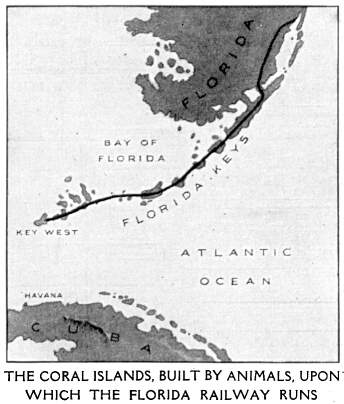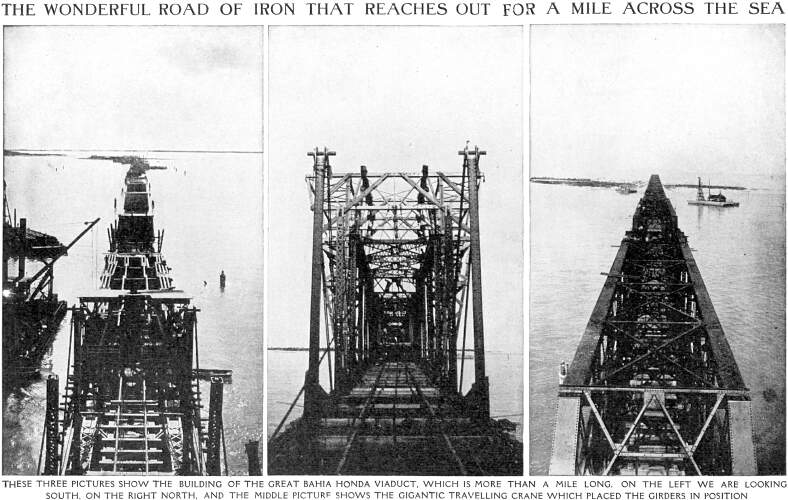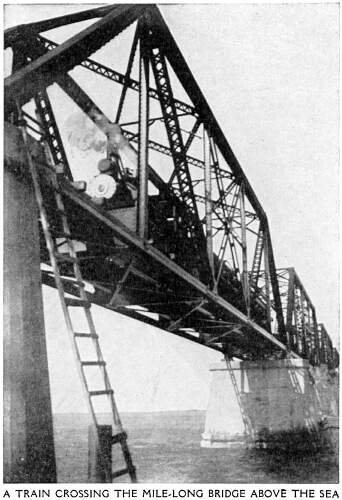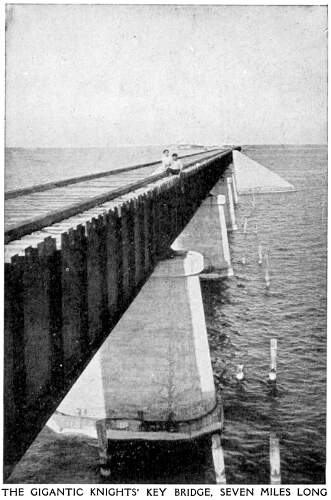STEPPING-STONES OVER THE SEA
HOW UNSEEN HANDS THROUGHOUT
THE AGES LAID THE
FOUNDATIONS OF THE MOST REMARKABLE RAILWAY IN THE WORLD
THE CORAL BUILDERS OF THE OCEAN BED
AMONG the smallest of living creatures
man finds some of his most useful allies. Tiny animals and insects
work, unconsciously, for his benefit. But perhaps there are not
many more astonishing stories in Nature than the story of the
little coral animals of the coast of Florida, which have laid
the foundations of a remarkable human achievement. Tiny soft bodied
animals, they extract mineral substances from the sea-water, and
form living skeleton dwellings. Millions of coral polyps are born,
labour, and die, and their work is carried on by still further
millions, till huge coral formations rise from the beds of shallow
seas. The work of these coral polyps has made possible a wonderful
American railway which has lately been opened to carry trains
out to sea.
 The purpose
of this railway is simply that a busy man, taking his seat in
a train in New York, only has to leave that train once before
he reaches Havana, which is the capital of Cuba, almost two thousand
miles away. To understand what that means we ought to peep for
a moment at the map. We see that not only must the American at
present make a long journey by land, but cross the open sea. Did
any of us ever go to sea in a train? Well, we can all do so by
travelling on this new railway, which is called the Florida East
Coast Railway Extension, and deserves to be known as one of the
greatest wonders of the modern world. The purpose
of this railway is simply that a busy man, taking his seat in
a train in New York, only has to leave that train once before
he reaches Havana, which is the capital of Cuba, almost two thousand
miles away. To understand what that means we ought to peep for
a moment at the map. We see that not only must the American at
present make a long journey by land, but cross the open sea. Did
any of us ever go to sea in a train? Well, we can all do so by
travelling on this new railway, which is called the Florida East
Coast Railway Extension, and deserves to be known as one of the
greatest wonders of the modern world.
From the point at which the railway goes out to sea to the
point at which the line stops is a distance of 156 miles. Then
we have the open Florida Strait, across which it would be unsafe
to build a railway. Here there is a large ferry-boat for goods
trains, but the passengers alight from the train and get on to
a boat which takes them to Havana, a further distance of ninety-miles.
All this sounds "frightfully fascinating," as Wendy
says, but what have the tiny polyps to do with it? They built
the foundations of the railway ages and ages ago. The busy little
coral animals, building and building and building, raised an enormous
number of islands of coral from below the water to the surface
of the waves, and those islands serve now to carry the lines for
the new railway. Some of the islands are so big that they support
quite a good length of track; but their use generally lies in
the fact that they are built close together, so the engineers
have been able to build great embankments and viaducts to join
them together, enabling the train to run along from island to
island, as comfortably as if it were on the line from New York
to Boston. But for these wonderful little creatures there could
have been no railway from Miami out over the waters to Key West.
Key West is itself on one of these islands, and is of great
importance to the United States, for it is a naval station at
which ocean-going vessels call, and it is the nearest naval base
to the new Panama Canal. From Key West to the coast of Florida
we have a chain of stepping-stones for the railway which the coral
animals have built. We have all seen the steppingstones which
are set in the course of shallow streams to enable us to cross
the water without getting wet. The coral islands serve the same
purpose for the railway; but, of course, there they are much more
important, and instead of one or two pairs of hands being required
to do the work necessary for making the crossing, this railway
has employed 3000 men to take advantage of its steppingstones,
and a sum of more than $20,000,000 has been spent to complete
the scheme.
As the railway is the most wonderful of its kind in the world,
we can profitably spend a few minutes in learning how the work
has been done; for it is as good as a fairy story, except for
the fact that there are some terrible tragedies to tell in connection
with it.
Before we build a railway we have to get surveyors carefully
to plan the line, and the surveyors for this line had a most difficult
task, for their work had to be done at sea, and often they had
to erect tall towers on which to place the instruments used for
the work. Some of the men engaged in the work got lost in what
are called the Everglades. This is an area in which there are
thousands of little islands, infested with swarms of fierce man-eating
alligators. In this tract, and among the many coral islands, or
keys, as they are called, farther out from the coast, men lost
themselves for days at a time, and had to be sought by relief
expeditions when on the brink of starvation and madness. But the
surveying was finished, as all things are finished when determined
men undertake the work, and the building began.
In the track of the railway lie forty-seven islands. Each of
these is made to carry a length of the railway. But there are
varying distances between the islands. In some cases the space
is only a few hundred yards, in others it is as much as six miles.
Where the distance was short it was easy to carry the line.
All that the engineers had to do was to imitate the coral animals,
and build up from the bottom of the water with concrete and stone
and steel. In this way an embankment was built joining island
to island. The embankments had to be raised to a height of thirty
feet above high water, and the bed on which the track crosses
the viaducts was laid at the same level. Careful examination has
shown that the highest waves in these seas do not teach more than
twenty-five feet; therefore the track is five feet above the top
of the highest wave.
We have used the word "viaduct," a word meaning,
as we all know, a bridge which carries us a distance over a chasm.
These viaducts are used for this railway where the distance between
the islands is too great for an embankment to serve. As we have
seen, there is in some cases six miles of sea between one island
and the next. Here, in some cases, the engineers built out embankments
from each island; then, when they could go no farther, they joined
the ends of the two embankments together with a great viaduct.
To build these viaducts they had to sink dummy piers, arched in
shape, and force down into the bed of the sea watertight cofferdams,
from which the water could be pumped out. When the water was drawn
out, there was a space inside the cofferdams into which the men
could fix great rods of steel. Then they poured cement into the
cofferdams and allowed it twenty-eight days in which to set. At
the end of that time they drew away the timber framework, and
floated it off in barges, and there they had foundations on which
to build up the bed of the railway.

Although the distance between some of the islands is more than
six miles, the engineers found that by carefully building out
their embankments they needed in some cases to bridge distances
of only one or two miles. Even this is a big jump out across the
sea, of course. But one of the viaducts, that at Knight's Key,
is nearly seven miles long. It is built upon 185 great concrete
pillars and arches, and is one of the greatest triumphs of this
wonderful railway. But the whole distance of the railway over
the sea, including islands, embankments, and viaducts, is 128
miles. The material used in it is enormous. There are 286,000
barrels of cement; the crushed rock used would make a road 100
miles long, and one yard broad, and one yard high; the sand used
would give us a little beach 60 miles long, one yard high, and
one yard broad. The steel rods used weighed 5700 tons, and the
amount of wood employed would startle a timber merchant.
In this way the work was carried out. On the islands themselves
the line was laid at the right level. as upon any ordinary railway;
for the small gaps between the islands embankments were sunk in
the sea; for the greater distances embankments and viaducts were
called into existence. When the line had been carried out a distance
of 109 miles from Miami, the engineers built a railway station,
and called it Marathon, and they built a dock at the same place.
Here a new city has been brought into existence, with the sea
all round it, with a railway station for its front entrance and
a dock for its back premises. Ships bring things to one door and
trains carry them away from the other, and trains run all the
way from New York to Key West and Havana, carrying merchandise
only, and taking back from Havana the loads of fruits and other
foods which grow abundantly in the glorious climate and teeming
soil of the island of Cuba.
 To complete
the journey from Key West to the capital of Cuba, the passengers
must go on board ship, we remember. The ships draw up where the
line ends. There are railway tracks on board the ship, and on
to these the freight trains run. They are securely fixed, and
away they go. The trains carry the merchandise; the ships carry
the trains. Many people hope that some (lay similar steamers will
carry British trains across from England to France and will also
take passengers, and bring back French trains from France to England
by the like means. To complete
the journey from Key West to the capital of Cuba, the passengers
must go on board ship, we remember. The ships draw up where the
line ends. There are railway tracks on board the ship, and on
to these the freight trains run. They are securely fixed, and
away they go. The trains carry the merchandise; the ships carry
the trains. Many people hope that some (lay similar steamers will
carry British trains across from England to France and will also
take passengers, and bring back French trains from France to England
by the like means.
The Russians have for several years been in the habit of carrying
railway trains on ships across the great Siberian Lake Baikal.
The ships which carry these trains of the Trans-Siberian Railway
across that large inland sea were built by an English Company.
There has seldom been more romance in the making of a railway
than in the making of this one which we are now considering. The
work had to be done very largely from ships and boats. All sorts
of vessels were employed. There were steam tugs, large steamers,
launches driven by gasolene, boats fitted up with cranes and cement-mixers;
there was a great floating pile-driver; there was a floating machine
shop; there were scores and scores of barges and other craft for
carrying material; and there were, above all, the houseboats in
which the workers lived. Of these latter vessels there were fourteen,
each one being the home of 144 men. The white men lived on these
houseboats; the negroes lived in little wooden houses built on
the islands. These islands, which the coral polyps built, are
covered with glorious palms and other vegetation. planted by nature.
In one of the islands the engineers discovered a man who had lived
there, like a Robinson Crusoe, all alone for thirty years, feeding
on fruit and fish and birds. The food of the men was taken to
them by the railway company, so that they should lack no comfort;
and a hospital was built for them at Miami. The one thing that
the men could not have was intoxicating drink. Most of them were
very glad of this, but some of the black sheep tried to get it,
and boats carrying liquor would steal out to the works; but a
special guard was kept for these, and when the boats were caught
their crews were locked up, while the boats themselves were sunk.
Thus it was a happy and healthy colony carrying out the work in
a scene of wonderful natural beauty and splendour, but one in
which there were risks from the alligators, and risks, too, from
the weather.
Few men were able to work from start to finish of the railway,
the work being so bard, and, all told, 20,000 workmen laboured
from time to time in keeping the army of toilers up to 3000. Sometimes
gaps were caused by tragedies for which the work itself was not
responsible.
 There was a
terrible disaster when the arches of the Long Key Viaduct were
being built. Ninety of the arches had been completed when a tornado
swept down upon the scene. The finished arches stood the storm
well, but the framework of those which were in course of building
was overthrown and swept out to sea. Vessels were torn from their
anchorages and carried off to sea, and a great deal of property
was lost. The camps of the negroes on the islands were blown down,
and the men were in much danger. Worse still was the fate of many
of the men on the houseboats. One of these houseboats was torn
from her anchorage and driven by the raging wind out to sea, and
dashed to pieces on a reef. Before this happened, however, heroic
scenes on board were witnessed. There was a
terrible disaster when the arches of the Long Key Viaduct were
being built. Ninety of the arches had been completed when a tornado
swept down upon the scene. The finished arches stood the storm
well, but the framework of those which were in course of building
was overthrown and swept out to sea. Vessels were torn from their
anchorages and carried off to sea, and a great deal of property
was lost. The camps of the negroes on the islands were blown down,
and the men were in much danger. Worse still was the fate of many
of the men on the houseboats. One of these houseboats was torn
from her anchorage and driven by the raging wind out to sea, and
dashed to pieces on a reef. Before this happened, however, heroic
scenes on board were witnessed.
Many men were so horrified by panic that they collected together
down in the hold and waited for destruction. One of the engineers
gave his life for these poor men. He went below and begged them
to go up on deck, so that they might be ready to swim for life
when the vessel should strike. While he was persuading them to
come up and save themselves the vessel struck, and he was killed
by a falling beam as the upper part of the vessel was dashed in.
There were 145 men on board, and terrible scenes followed. Some
of the men, however, were as cool as if nothing were happening.
After the houseboat struck, no fewer than 87 men were rescued
at once from the sea. An Italian steamer went to their rescue
and saved 44 of them. She was not satisfied with this, but had
her boats out all night seeking others in the storm-tossed sea.
Many a time voices were heard crying out in the darkness, the
voices of men whom the brave boatmen were unable to find and save.
The British ship Alton rescued 26 of the men, and other vessels
passing on their way picked up more. For the next few weeks men
from the railway wreck were reported alive from all parts of the
world-from Galveston, New York, Buenos Ayres, from London, and
Liverpool. Ships passing on their way had rescued them and continued
their voyages, carrying the men with them.
Such are some of the adventures which the men have experienced
who have helped to make this wonderful railway out over the broad
sea. It is a sad tale, but those who came through the tragedy
are proud to tell of their adventures, and to declare that they
would go through it again for the glory of helping to build this
the most remarkable railway that the world has yet seen. All honour
to them for the work they have done, but we will not forget the
thanks due to the little builders of the coral islands. They cannot
speak for themselves to claim their share of glory.
This sea railway was finished a few years ago, and trains run
on it, with the waves off the Atlantic sending up spray on the
one side, while the Gulf of Mexico washes the foundation of the
railway on the other side. The undertaking has been carried out
at a cost of $150,000 per mile, making the Florida East Coast
Railway Extension one of the costliest in the world, except mountain
and city railways.
Drawbridge
of Great Knights' Key Viaduct
Long Key Viaduct
Train Passing Over the Long Key Viaduct
Track Thru Palm Trees
Joining Up Two Islands
Between Two Distant Islands
Stories Page | Contents Page
|







